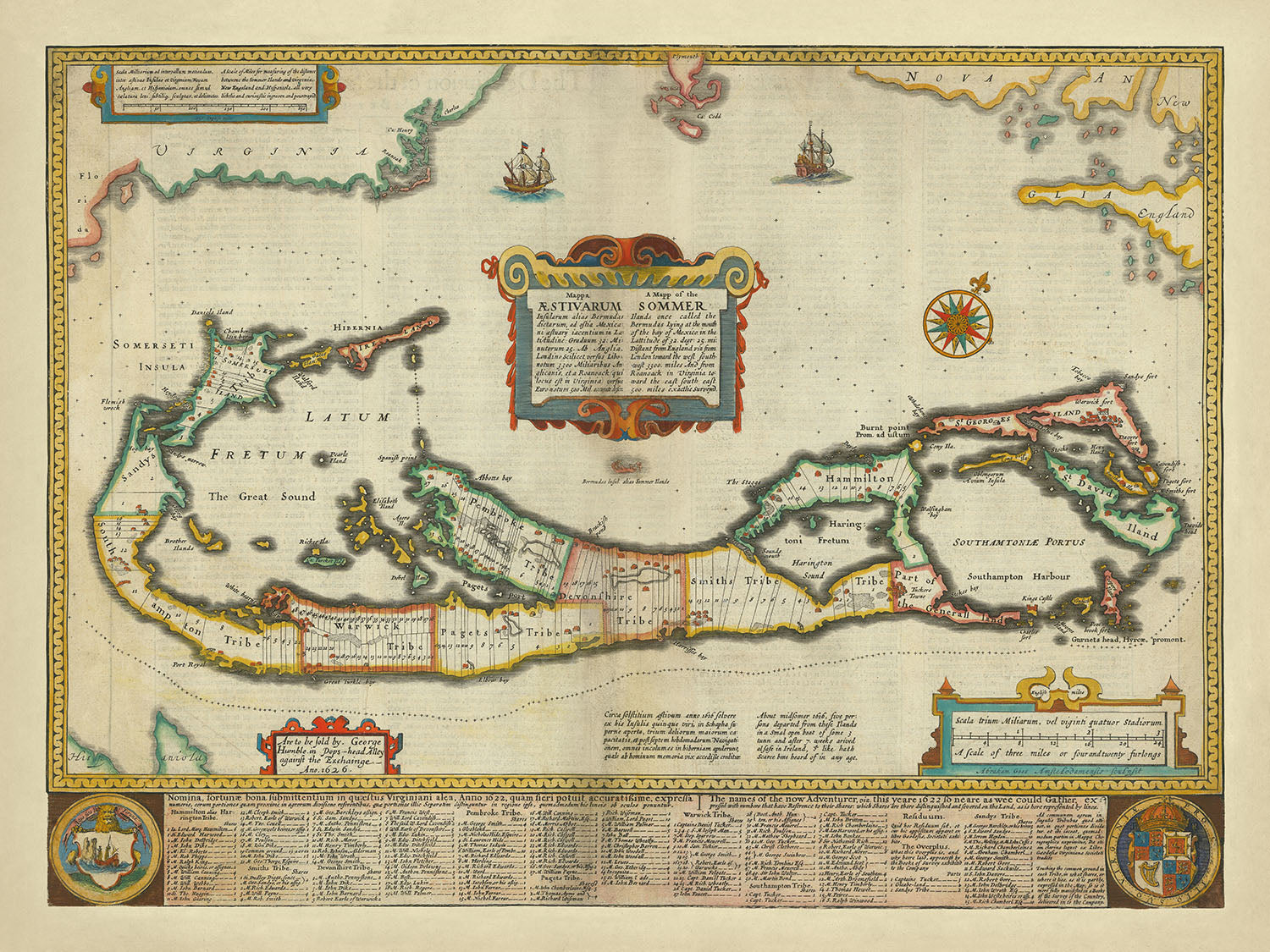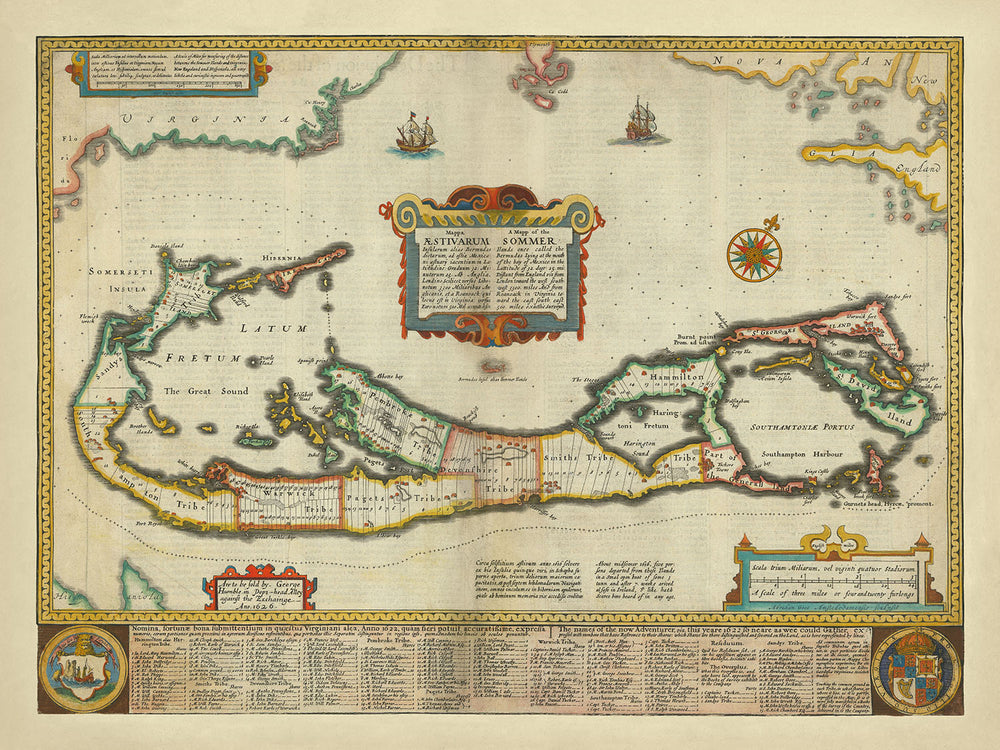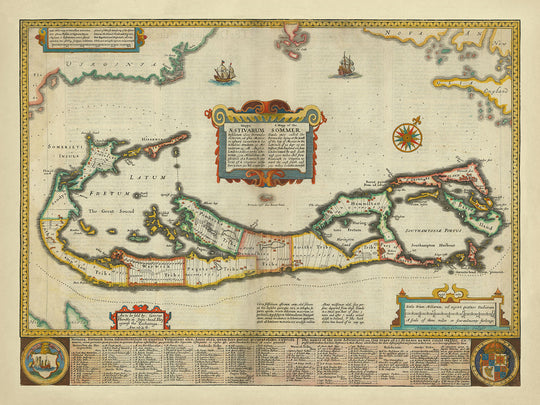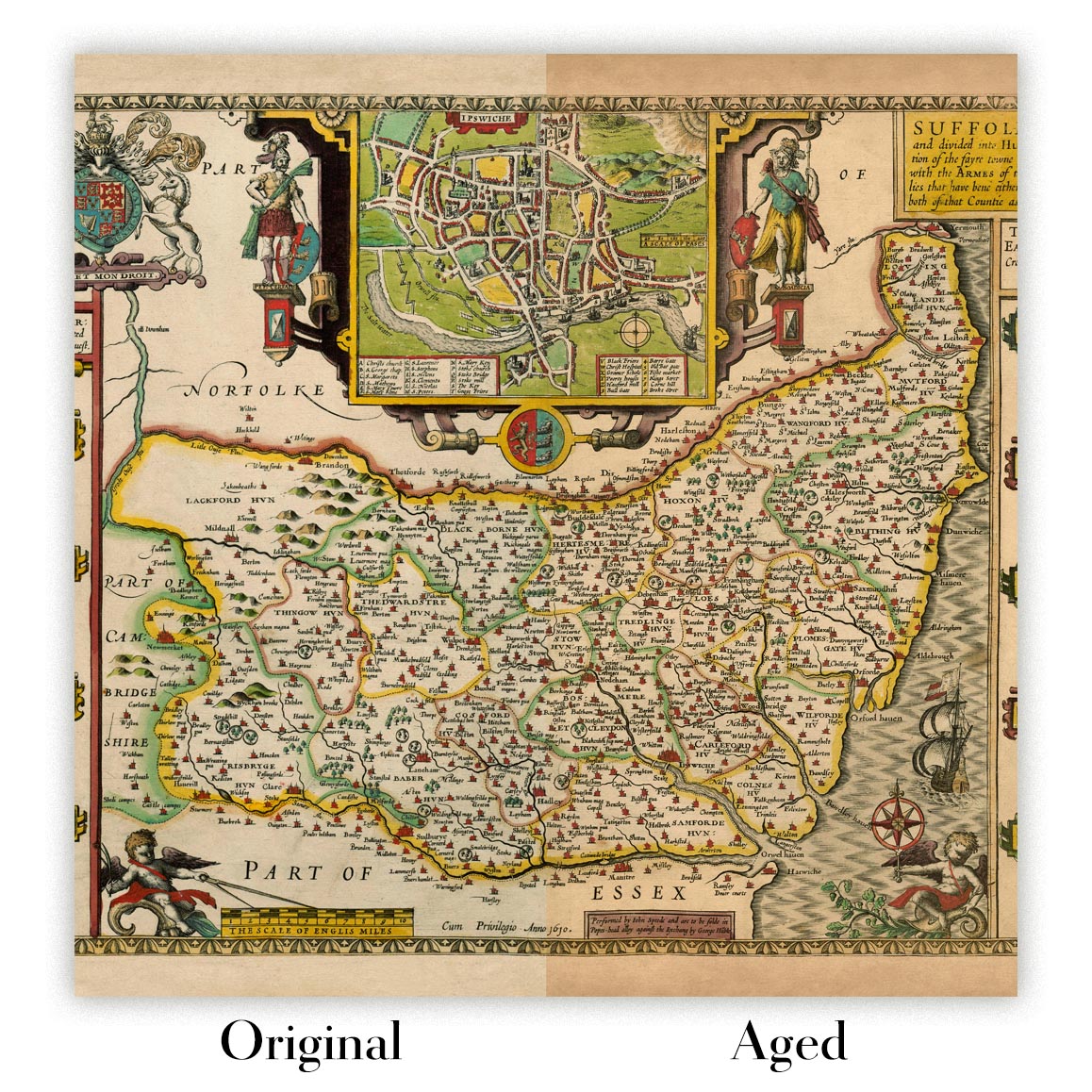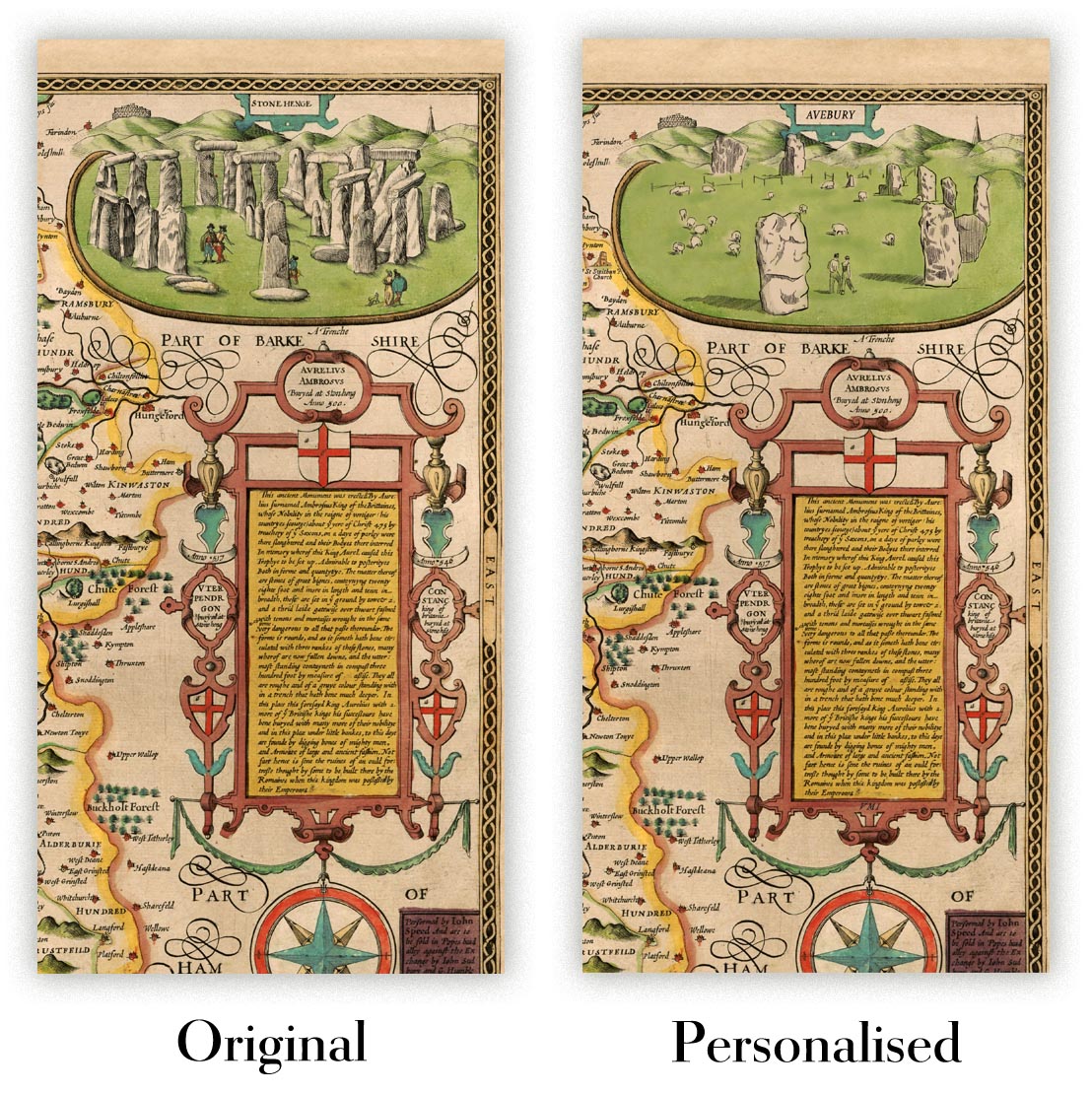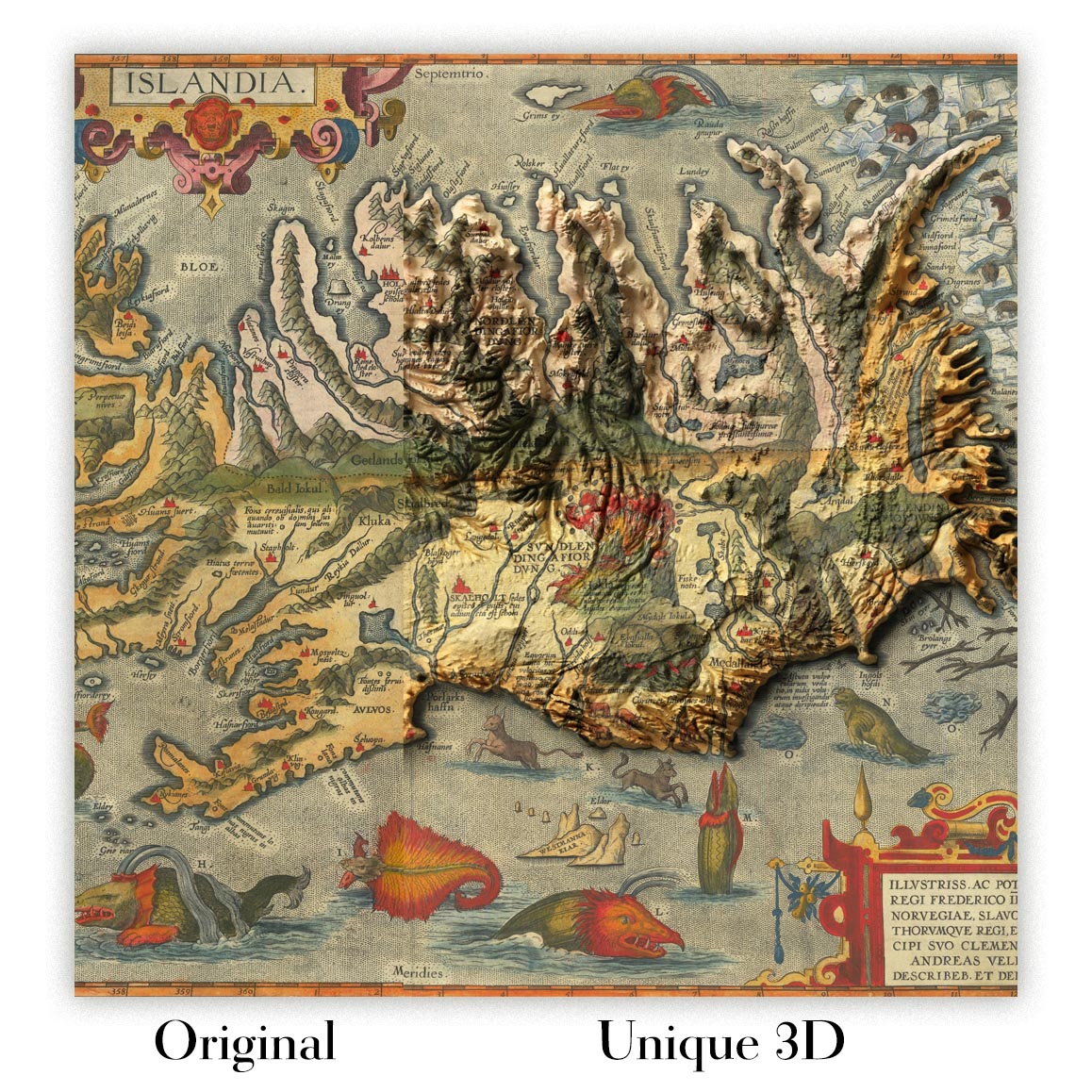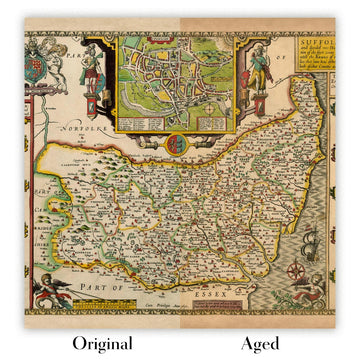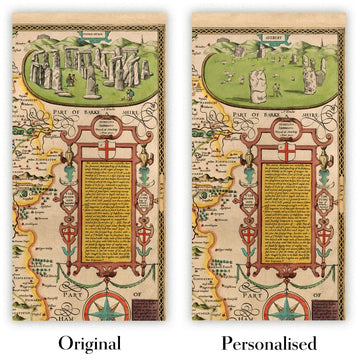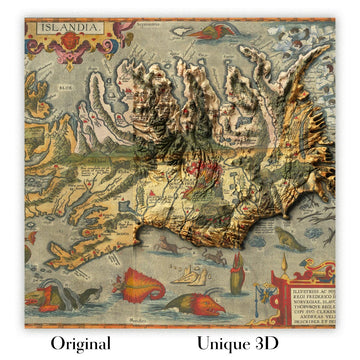- Handmade locally. No import duty or tax
- FREE worldwide delivery
- Love it or your money back (90 days)
- Questions? WhatsApp me any time
Own a piece of history
5,000+ 5 star reviews


Mappa Aestivarum Insularum alias Bermudas dictarum, or A Map of the Sommer Ilands once called Bermudas, is a masterful creation by the renowned cartographer John Speed, published in 1627. This exquisite map was compiled by Richard Norwood in 1622 and stands as the first English printed map to depict Bermuda divided into Tribes and Shares. These divisions were meticulously designated to represent the properties allocated to the 'Adventurers,' led by Sir George Sommers, following their shipwreck in 1609. The map’s title, elegantly presented in both English and Latin, adds a touch of historical gravitas to this cartographic gem.
John Speed, a celebrated English cartographer, is best known for his detailed and decorative maps. His work on Bermuda, engraved by Abraham Goos in Amsterdam, is no exception. The imprint of George Humble, another significant figure in the map’s production, is prominently displayed. Speed's map became the standard representation of Bermuda in the 17th century, influencing subsequent maps by notable cartographers such as Blaeu, Jansson, and Ogilby. This map not only showcases Speed's cartographic prowess but also reflects the collaborative efforts of some of the era's most skilled engravers and publishers.
The map vividly illustrates Bermuda’s political landscape, divided into Tribes and Shares, each meticulously labeled. These divisions highlight the land distributed to the 'Adventurers,' providing a fascinating glimpse into the early colonial history of Bermuda. The map also features various landmarks, such as Burnt Point and Gurnet Head, which are intricately detailed, offering a window into the geographical knowledge of the time. The Great Sound, Southampton Harbour, and Hamilton Fretum are among the notable bodies of water depicted, emphasizing the island's maritime significance.
Decorative elements abound in this map, enhancing its visual appeal. Sailing ships, a vibrant compass rose, four ornate cartouches, and two coats of arms embellish the map, making it not only a valuable historical document but also a piece of art. The meticulous craftsmanship of Abraham Goos is evident in these embellishments, which add a layer of elegance and sophistication to the map. The inclusion of English text on the verso further enriches the map, providing additional context and information for the discerning collector.
This map is not just a representation of Bermuda; it is a testament to the island's historical and geographical significance. The detailed depiction of cities and towns, such as Hamilton, St. George's, and Somerset, along with the intricate divisions of Tribes and Shares, offers a unique insight into the early colonial era. The map's historical importance is underscored by its role as the standard map of Bermuda in the 17th century, a status that solidifies its place in the annals of cartographic history. Owning this map is akin to holding a piece of history, a tangible connection to the past that continues to captivate and inspire.
Cities and towns on this map
- Hamilton (modern-day capital city of Bermuda)
- St. George's
- Somerset
- Harrington
- Southampton
- Smith's
- Devonshire
- Warwick
Notable Features & Landmarks
- Illustrations:
- Sailing ships
- Compass rose
- Four cartouches
- Two coats of arms
- Landmarks:
- Burnt Point
- Gurnet Head
- Bodies of water:
- The Great Sound
- Southampton Harbour
- Hamilton Fretum
- Borders:
- Divisions into Tribes and Shares
- Other notable features:
- Scale of miles
- Imprints of Abraham Goos and George Humble
Historical and design context
- Name of the map: Mappa Aestivarum Insularum alias Bermudas dictarum | A Map of the Sommer Ilands once called Bermudas . . . 1626
- Creation date: 1627
- Mapmaker/Publisher: John Speed
- Additional context: The map was engraved by Abraham Goos in Amsterdam for Speed's "Prospect" and his imprint appears below the scale of miles. The imprint of George Humble is at left.
- Compiled by: Richard Norwood in 1622
- Themes and topics shown:
- Political divisions: The map shows Bermuda divided into Tribes and Shares, designating properties given to the 'Adventurers' led by Sir George Sommers.
- Historical context: The divisions on the map correspond to properties distributed after the shipwreck of 1609.
- Countries and regions shown: Bermuda, with some references to surrounding areas such as Virginia and New England
- Design and style:
- Decorative elements: Embellished with sailing ships, a compass rose, four cartouches, and two coats of arms
- Language: Titles and labels are in both English and Latin
- Text: English text on the verso
- Historical significance:
- First English printed map: The first English printed map published in an atlas to show Bermuda divided into Tribes and Shares
- Influence: Became the standard map of Bermuda in the 17th century and was copied by notable cartographers such as Blaeu, Jansson, and Ogilby
Please double check the images to make sure that a specific town or place is shown on this map. You can also get in touch and ask us to check the map for you.
This map looks great at every size, but I always recommend going for a larger size if you have space. That way you can easily make out all of the details.
This map looks amazing at sizes all the way up to 90in (230cm). If you are looking for a larger map, please get in touch.
The model in the listing images is holding the 18x24in (45x60cm) version of this map.
The fifth listing image shows an example of my map personalisation service.
If you’re looking for something slightly different, check out my collection of the best old maps to see if something else catches your eye.
Please contact me to check if a certain location, landmark or feature is shown on this map.
This would make a wonderful birthday, Christmas, Father's Day, work leaving, anniversary or housewarming gift for someone from the areas covered by this map.
This map is available as a giclée print on acid free archival matte paper, or you can buy it framed. The frame is a nice, simple black frame that suits most aesthetics. Please get in touch if you'd like a different frame colour or material. My frames are glazed with super-clear museum-grade acrylic (perspex/acrylite), which is significantly less reflective than glass, safer, and will always arrive in perfect condition.
This map is also available as a float framed canvas, sometimes known as a shadow gap framed canvas or canvas floater. The map is printed on artist's cotton canvas and then stretched over a handmade box frame. We then "float" the canvas inside a wooden frame, which is available in a range of colours (black, dark brown, oak, antique gold and white). This is a wonderful way to present a map without glazing in front. See some examples of float framed canvas maps and explore the differences between my different finishes.
For something truly unique, this map is also available in "Unique 3D", our trademarked process that dramatically transforms the map so that it has a wonderful sense of depth. We combine the original map with detailed topography and elevation data, so that mountains and the terrain really "pop". For more info and examples of 3D maps, check my Unique 3D page.
For most orders, delivery time is about 3 working days. Personalised and customised products take longer, as I have to do the personalisation and send it to you for approval, which usually takes 1 or 2 days.
Please note that very large framed orders usually take longer to make and deliver.
If you need your order to arrive by a certain date, please contact me before you order so that we can find the best way of making sure you get your order in time.
I print and frame maps and artwork in 23 countries around the world. This means your order will be made locally, which cuts down on delivery time and ensures that it won't be damaged during delivery. You'll never pay customs or import duty, and we'll put less CO2 into the air.
All of my maps and art prints are well packaged and sent in a rugged tube if unframed, or surrounded by foam if framed.
I try to send out all orders within 1 or 2 days of receiving your order, though some products (like face masks, mugs and tote bags) can take longer to make.
If you select Express Delivery at checkout your order we will prioritise your order and send it out by 1-day courier (Fedex, DHL, UPS, Parcelforce).
Next Day delivery is also available in some countries (US, UK, Singapore, UAE) but please try to order early in the day so that we can get it sent out on time.
My standard frame is a gallery style black ash hardwood frame. It is simple and quite modern looking. My standard frame is around 20mm (0.8in) wide.
I use super-clear acrylic (perspex/acrylite) for the frame glass. It's lighter and safer than glass - and it looks better, as the reflectivity is lower.
Six standard frame colours are available for free (black, dark brown, dark grey, oak, white and antique gold). Custom framing and mounting/matting is available if you're looking for something else.
Most maps, art and illustrations are also available as a framed canvas. We use matte (not shiny) cotton canvas, stretch it over a sustainably sourced box wood frame, and then 'float' the piece within a wood frame. The end result is quite beautiful, and there's no glazing to get in the way.
All frames are provided "ready to hang", with either a string or brackets on the back. Very large frames will have heavy duty hanging plates and/or a mounting baton. If you have any questions, please get in touch.
See some examples of my framed maps and framed canvas maps.
Alternatively, I can also supply old maps and artwork on canvas, foam board, cotton rag and other materials.
If you want to frame your map or artwork yourself, please read my size guide first.
My maps are extremely high quality reproductions of original maps.
I source original, rare maps from libraries, auction houses and private collections around the world, restore them at my London workshop, and then use specialist giclée inks and printers to create beautiful maps that look even better than the original.
My maps are printed on acid-free archival matte (not glossy) paper that feels very high quality and almost like card. In technical terms the paper weight/thickness is 10mil/200gsm. It's perfect for framing.
I print with Epson ultrachrome giclée UV fade resistant pigment inks - some of the best inks you can find.
I can also make maps on canvas, cotton rag and other exotic materials.
Learn more about The Unique Maps Co.
Map personalisation
If you're looking for the perfect anniversary or housewarming gift, I can personalise your map to make it truly unique. For example, I can add a short message, or highlight an important location, or add your family's coat of arms.
The options are almost infinite. Please see my map personalisation page for some wonderful examples of what's possible.
To order a personalised map, select "personalise your map" before adding it to your basket.
Get in touch if you're looking for more complex customisations and personalisations.
Map ageing
I have been asked hundreds of times over the years by customers if they could buy a map that looks even older.
Well, now you can, by selecting Aged before you add a map to your basket.
All the product photos you see on this page show the map in its Original form. This is what the map looks like today.
If you select Aged, I will age your map by hand, using a special and unique process developed through years of studying old maps, talking to researchers to understand the chemistry of aging paper, and of course... lots of practice!
If you're unsure, stick to the Original colour of the map. If you want something a bit darker and older looking, go for Aged.
If you are not happy with your order for any reason, contact me and I'll get it fixed ASAP, free of charge. Please see my returns and refund policy for more information.
I am very confident you will like your restored map or art print. I have been doing this since 1984. I'm a 5-star Etsy seller. I have sold tens of thousands of maps and art prints and have over 5,000 real 5-star reviews. My work has been featured in interior design magazines, on the BBC, and on the walls of dozens of 5-star hotels.
I use a unique process to restore maps and artwork that is massively time consuming and labour intensive. Hunting down the original maps and illustrations can take months. I use state of the art and eye-wateringly expensive technology to scan and restore them. As a result, I guarantee my maps and art prints are a cut above the rest. I stand by my products and will always make sure you're 100% happy with what you receive.
Almost all of my maps and art prints look amazing at large sizes (200cm, 6.5ft+) and I can frame and deliver them to you as well, via special oversized courier. Contact me to discuss your specific needs.
Or try searching for something!







